2005 CHEVROLET SILVERADO service indicator
[x] Cancel search: service indicatorPage 448 of 580
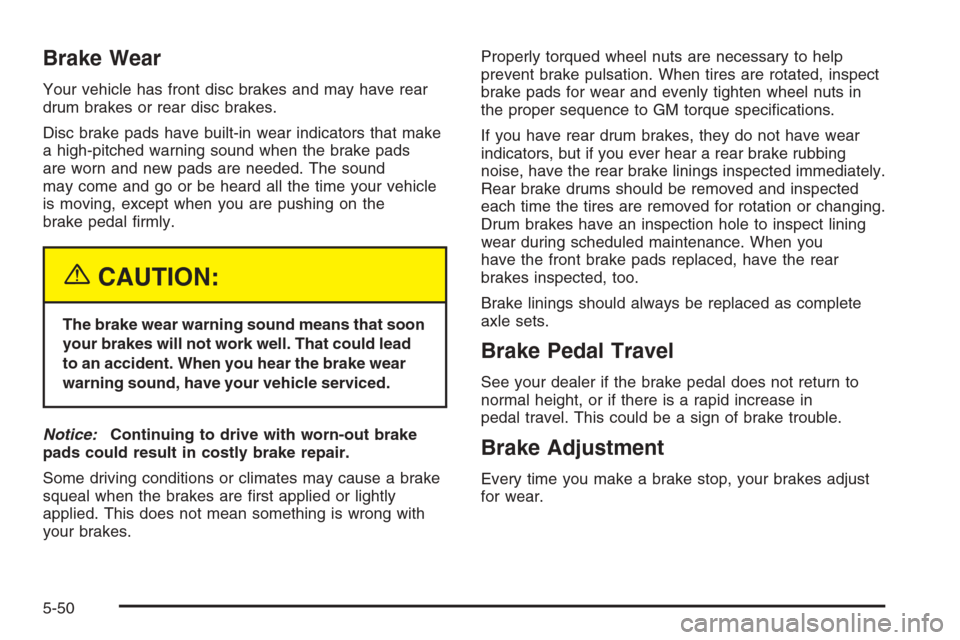
Brake Wear
Your vehicle has front disc brakes and may have rear
drum brakes or rear disc brakes.
Disc brake pads have built-in wear indicators that make
a high-pitched warning sound when the brake pads
are worn and new pads are needed. The sound
may come and go or be heard all the time your vehicle
is moving, except when you are pushing on the
brake pedal �rmly.
{CAUTION:
The brake wear warning sound means that soon
your brakes will not work well. That could lead
to an accident. When you hear the brake wear
warning sound, have your vehicle serviced.
Notice:Continuing to drive with worn-out brake
pads could result in costly brake repair.
Some driving conditions or climates may cause a brake
squeal when the brakes are �rst applied or lightly
applied. This does not mean something is wrong with
your brakes.Properly torqued wheel nuts are necessary to help
prevent brake pulsation. When tires are rotated, inspect
brake pads for wear and evenly tighten wheel nuts in
the proper sequence to GM torque speci�cations.
If you have rear drum brakes, they do not have wear
indicators, but if you ever hear a rear brake rubbing
noise, have the rear brake linings inspected immediately.
Rear brake drums should be removed and inspected
each time the tires are removed for rotation or changing.
Drum brakes have an inspection hole to inspect lining
wear during scheduled maintenance. When you
have the front brake pads replaced, have the rear
brakes inspected, too.
Brake linings should always be replaced as complete
axle sets.
Brake Pedal Travel
See your dealer if the brake pedal does not return to
normal height, or if there is a rapid increase in
pedal travel. This could be a sign of brake trouble.
Brake Adjustment
Every time you make a brake stop, your brakes adjust
for wear.
5-50
Page 482 of 580
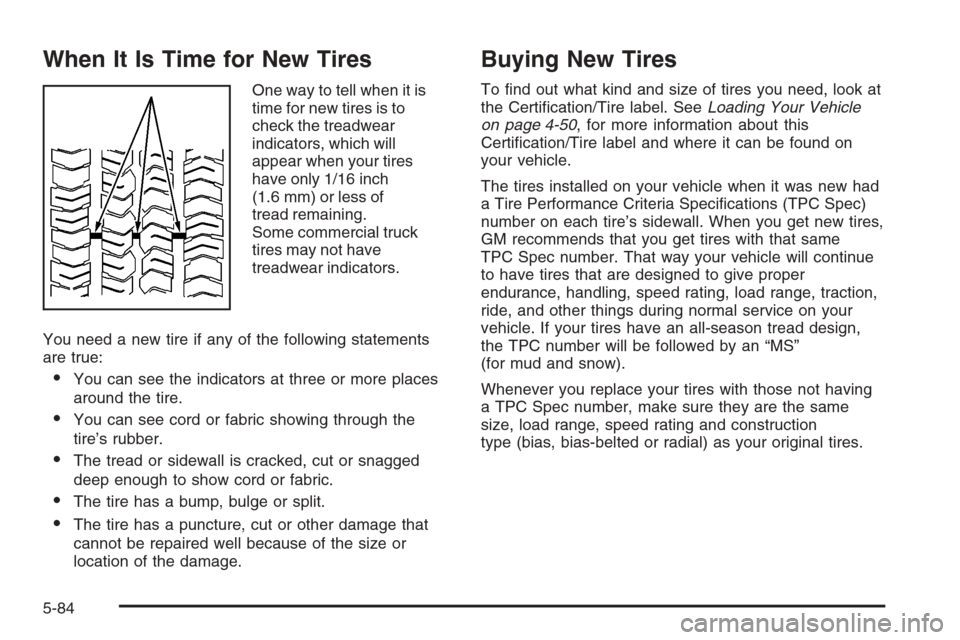
When It Is Time for New Tires
One way to tell when it is
time for new tires is to
check the treadwear
indicators, which will
appear when your tires
have only 1/16 inch
(1.6 mm) or less of
tread remaining.
Some commercial truck
tires may not have
treadwear indicators.
You need a new tire if any of the following statements
are true:
You can see the indicators at three or more places
around the tire.
You can see cord or fabric showing through the
tire’s rubber.
The tread or sidewall is cracked, cut or snagged
deep enough to show cord or fabric.
The tire has a bump, bulge or split.
The tire has a puncture, cut or other damage that
cannot be repaired well because of the size or
location of the damage.
Buying New Tires
To �nd out what kind and size of tires you need, look at
the Certi�cation/Tire label. SeeLoading Your Vehicle
on page 4-50, for more information about this
Certi�cation/Tire label and where it can be found on
your vehicle.
The tires installed on your vehicle when it was new had
a Tire Performance Criteria Speci�cations (TPC Spec)
number on each tire’s sidewall. When you get new tires,
GM recommends that you get tires with that same
TPC Spec number. That way your vehicle will continue
to have tires that are designed to give proper
endurance, handling, speed rating, load range, traction,
ride, and other things during normal service on your
vehicle. If your tires have an all-season tread design,
the TPC number will be followed by an “MS”
(for mud and snow).
Whenever you replace your tires with those not having
a TPC Spec number, make sure they are the same
size, load range, speed rating and construction
type (bias, bias-belted or radial) as your original tires.
5-84
Page 539 of 580
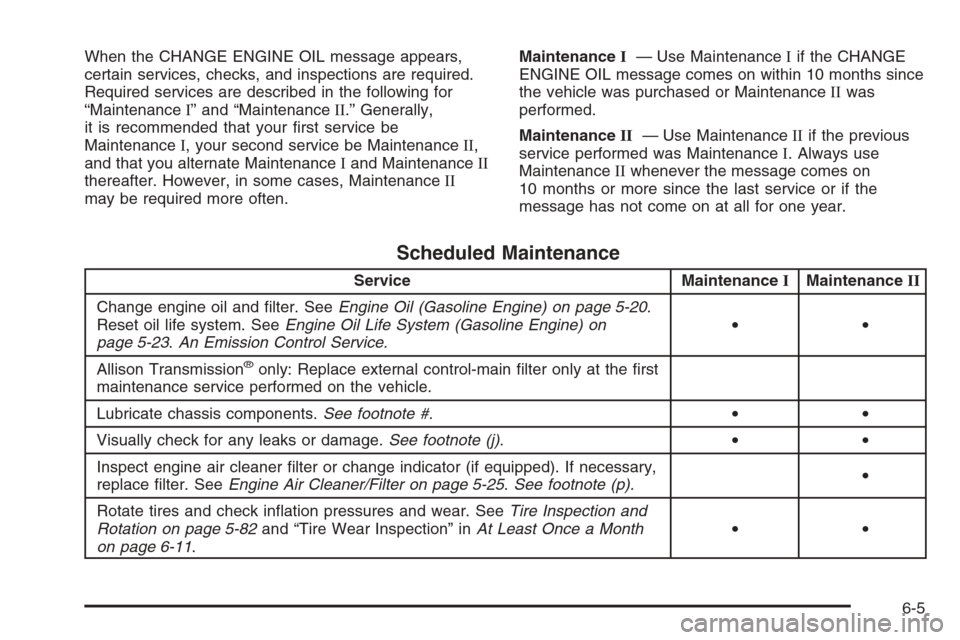
When the CHANGE ENGINE OIL message appears,
certain services, checks, and inspections are required.
Required services are described in the following for
“MaintenanceI” and “MaintenanceII.” Generally,
it is recommended that your �rst service be
MaintenanceI, your second service be MaintenanceII,
and that you alternate MaintenanceIand MaintenanceII
thereafter. However, in some cases, MaintenanceII
may be required more often.MaintenanceI— Use MaintenanceIif the CHANGE
ENGINE OIL message comes on within 10 months since
the vehicle was purchased or MaintenanceIIwas
performed.
MaintenanceII— Use MaintenanceIIif the previous
service performed was MaintenanceI. Always use
MaintenanceIIwhenever the message comes on
10 months or more since the last service or if the
message has not come on at all for one year.
Scheduled Maintenance
Service MaintenanceIMaintenanceII
Change engine oil and �lter. SeeEngine Oil (Gasoline Engine) on page 5-20.
Reset oil life system. SeeEngine Oil Life System (Gasoline Engine) on
page 5-23.An Emission Control Service.••
Allison Transmission
®only: Replace external control-main �lter only at the �rst
maintenance service performed on the vehicle.
Lubricate chassis components.See footnote #.••
Visually check for any leaks or damage.See footnote (j).••
Inspect engine air cleaner �lter or change indicator (if equipped). If necessary,
replace �lter. SeeEngine Air Cleaner/Filter on page 5-25.See footnote (p).•
Rotate tires and check in�ation pressures and wear. SeeTire Inspection and
Rotation on page 5-82and “Tire Wear Inspection” inAt Least Once a Month
on page 6-11.••
6-5
Page 541 of 580
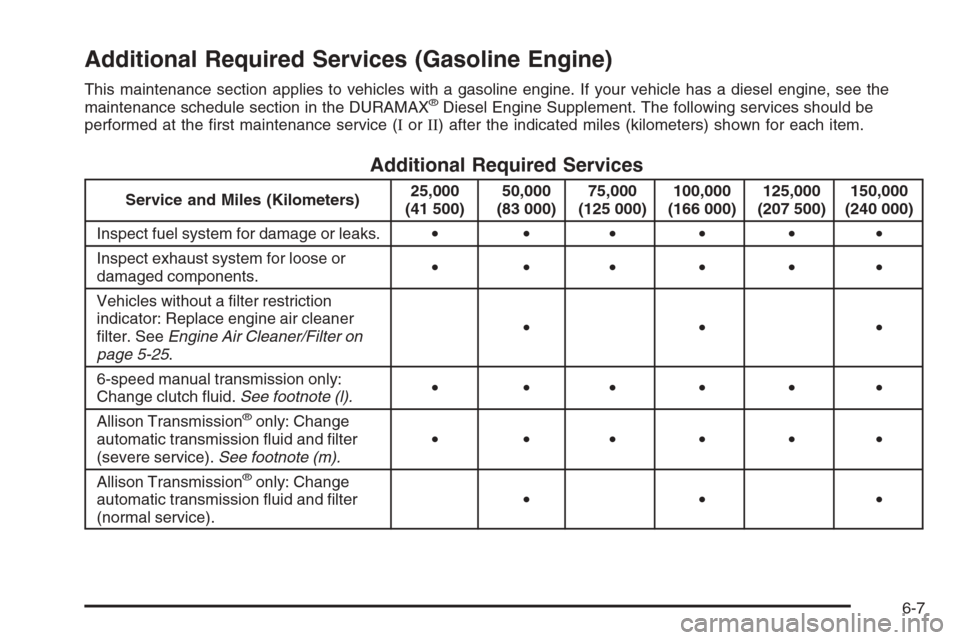
Additional Required Services (Gasoline Engine)
This maintenance section applies to vehicles with a gasoline engine. If your vehicle has a diesel engine, see the
maintenance schedule section in the DURAMAX®Diesel Engine Supplement. The following services should be
performed at the �rst maintenance service (IorII) after the indicated miles (kilometers) shown for each item.
Additional Required Services
Service and Miles (Kilometers)25,000
(41 500)50,000
(83 000)75,000
(125 000)100,000
(166 000)125,000
(207 500)150,000
(240 000)
Inspect fuel system for damage or leaks.• •••••
Inspect exhaust system for loose or
damaged components.• •••••
Vehicles without a �lter restriction
indicator: Replace engine air cleaner
�lter. SeeEngine Air Cleaner/Filter on
page 5-25.•• •
6-speed manual transmission only:
Change clutch �uid.See footnote (l).• •••••
Allison Transmission
®only: Change
automatic transmission �uid and �lter
(severe service).See footnote (m).• •••••
Allison Transmission
®only: Change
automatic transmission �uid and �lter
(normal service).•• •
6-7
Page 544 of 580
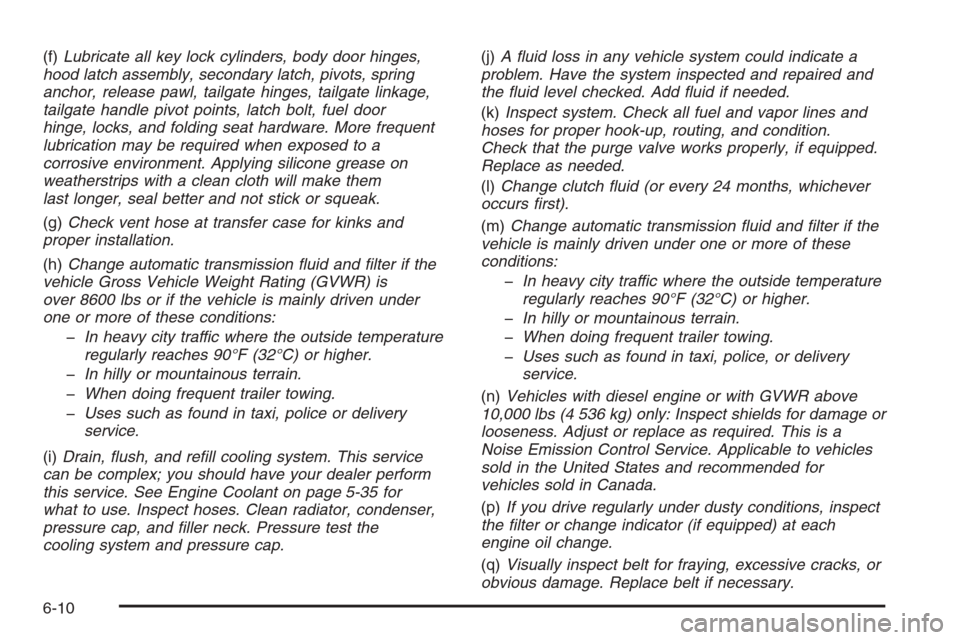
(f)Lubricate all key lock cylinders, body door hinges,
hood latch assembly, secondary latch, pivots, spring
anchor, release pawl, tailgate hinges, tailgate linkage,
tailgate handle pivot points, latch bolt, fuel door
hinge, locks, and folding seat hardware. More frequent
lubrication may be required when exposed to a
corrosive environment. Applying silicone grease on
weatherstrips with a clean cloth will make them
last longer, seal better and not stick or squeak.
(g)Check vent hose at transfer case for kinks and
proper installation.
(h)Change automatic transmission �uid and �lter if the
vehicle Gross Vehicle Weight Rating (GVWR) is
over 8600 lbs or if the vehicle is mainly driven under
one or more of these conditions:
�In heavy city traffic where the outside temperature
regularly reaches 90°F (32°C) or higher.
�In hilly or mountainous terrain.
�When doing frequent trailer towing.
�Uses such as found in taxi, police or delivery
service.
(i)Drain, �ush, and re�ll cooling system. This service
can be complex; you should have your dealer perform
this service. See Engine Coolant on page 5-35 for
what to use. Inspect hoses. Clean radiator, condenser,
pressure cap, and �ller neck. Pressure test the
cooling system and pressure cap.(j)A �uid loss in any vehicle system could indicate a
problem. Have the system inspected and repaired and
the �uid level checked. Add �uid if needed.
(k)Inspect system. Check all fuel and vapor lines and
hoses for proper hook-up, routing, and condition.
Check that the purge valve works properly, if equipped.
Replace as needed.
(l)Change clutch �uid (or every 24 months, whichever
occurs �rst).
(m)Change automatic transmission �uid and �lter if the
vehicle is mainly driven under one or more of these
conditions:
�In heavy city traffic where the outside temperature
regularly reaches 90°F (32°C) or higher.
�In hilly or mountainous terrain.
�When doing frequent trailer towing.
�Uses such as found in taxi, police, or delivery
service.
(n)Vehicles with diesel engine or with GVWR above
10,000 lbs (4 536 kg) only: Inspect shields for damage or
looseness. Adjust or replace as required. This is a
Noise Emission Control Service. Applicable to vehicles
sold in the United States and recommended for
vehicles sold in Canada.
(p)If you drive regularly under dusty conditions, inspect
the �lter or change indicator (if equipped) at each
engine oil change.
(q)Visually inspect belt for fraying, excessive cracks, or
obvious damage. Replace belt if necessary.
6-10
Page 574 of 580
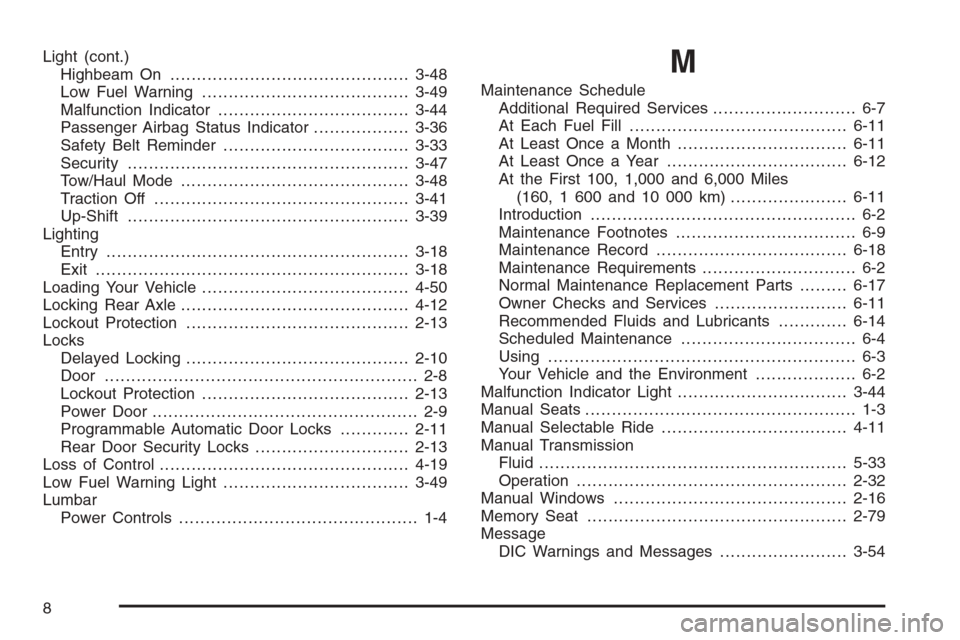
Light (cont.)
Highbeam On.............................................3-48
Low Fuel Warning.......................................3-49
Malfunction Indicator....................................3-44
Passenger Airbag Status Indicator..................3-36
Safety Belt Reminder...................................3-33
Security.....................................................3-47
Tow/Haul Mode ...........................................3-48
Traction Off................................................3-41
Up-Shift.....................................................3-39
Lighting
Entry.........................................................3-18
Exit ...........................................................3-18
Loading Your Vehicle.......................................4-50
Locking Rear Axle...........................................4-12
Lockout Protection..........................................2-13
Locks
Delayed Locking..........................................2-10
Door ........................................................... 2-8
Lockout Protection.......................................2-13
Power Door .................................................. 2-9
Programmable Automatic Door Locks.............2-11
Rear Door Security Locks.............................2-13
Loss of Control...............................................4-19
Low Fuel Warning Light...................................3-49
Lumbar
Power Controls............................................. 1-4M
Maintenance Schedule
Additional Required Services........................... 6-7
At Each Fuel Fill.........................................6-11
At Least Once a Month................................6-11
At Least Once a Year..................................6-12
At the First 100, 1,000 and 6,000 Miles
(160, 1 600 and 10 000 km)......................6-11
Introduction.................................................. 6-2
Maintenance Footnotes.................................. 6-9
Maintenance Record....................................6-18
Maintenance Requirements............................. 6-2
Normal Maintenance Replacement Parts.........6-17
Owner Checks and Services.........................6-11
Recommended Fluids and Lubricants.............6-14
Scheduled Maintenance................................. 6-4
Using.......................................................... 6-3
Your Vehicle and the Environment................... 6-2
Malfunction Indicator Light................................3-44
Manual Seats................................................... 1-3
Manual Selectable Ride...................................4-11
Manual Transmission
Fluid..........................................................5-33
Operation...................................................2-32
Manual Windows............................................2-16
Memory Seat.................................................2-79
Message
DIC Warnings and Messages........................3-54
8
Page 580 of 580
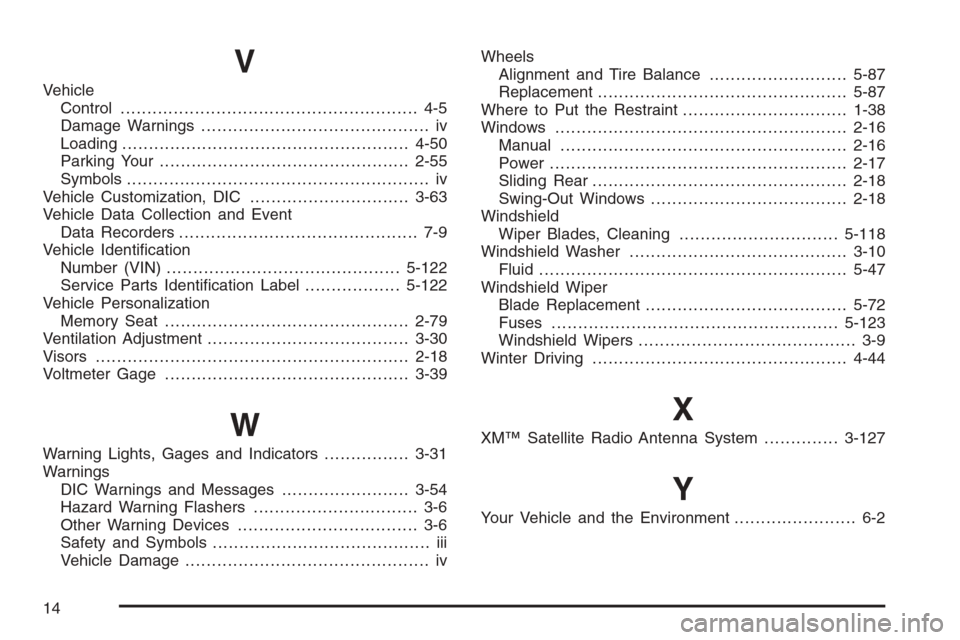
V
Vehicle
Control........................................................ 4-5
Damage Warnings........................................... iv
Loading......................................................4-50
Parking Your...............................................2-55
Symbols......................................................... iv
Vehicle Customization, DIC..............................3-63
Vehicle Data Collection and Event
Data Recorders............................................. 7-9
Vehicle Identi�cation
Number (VIN)............................................5-122
Service Parts Identi�cation Label..................5-122
Vehicle Personalization
Memory Seat..............................................2-79
Ventilation Adjustment......................................3-30
Visors...........................................................2-18
Voltmeter Gage..............................................3-39
W
Warning Lights, Gages and Indicators................3-31
Warnings
DIC Warnings and Messages........................3-54
Hazard Warning Flashers............................... 3-6
Other Warning Devices.................................. 3-6
Safety and Symbols......................................... iii
Vehicle Damage.............................................. ivWheels
Alignment and Tire Balance..........................5-87
Replacement...............................................5-87
Where to Put the Restraint...............................1-38
Windows.......................................................2-16
Manual......................................................2-16
Power ........................................................2-17
Sliding Rear................................................2-18
Swing-Out Windows.....................................2-18
Windshield
Wiper Blades, Cleaning..............................5-118
Windshield Washer.........................................3-10
Fluid..........................................................5-47
Windshield Wiper
Blade Replacement......................................5-72
Fuses......................................................5-123
Windshield Wipers......................................... 3-9
Winter Driving................................................4-44
X
XM™ Satellite Radio Antenna System..............3-127
Y
Your Vehicle and the Environment....................... 6-2
14